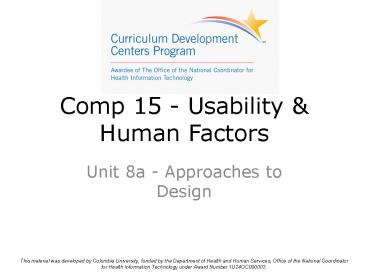Comp 15 - Usability - PowerPoint PPT Presentation
Title:
Comp 15 - Usability
Description:
Comp 15 - Usability & Human Factors Unit 8a - Approaches to Design This material was developed by Columbia University, funded by the Department of Health and Human ... – PowerPoint PPT presentation
Number of Views:115
Avg rating:3.0/5.0
Title: Comp 15 - Usability
1
Comp 15 - Usability Human Factors
- Unit 8a - Approaches to Design
This material was developed by Columbia
University, funded by the Department of Health
and Human Services, Office of the National
Coordinator for Health Information Technology
under Award Number 1U24OC000003.
2
Overview
- Interaction Design
- User-Centered Design
- Lifecycle Models of Software Engineering
- Usability engineering lifecycle
- Prototypes
- A case study of participatory design
- Heuristic design principles
3
Design
- A plan or scheme conceived in mind and intended
for subsequent execution - Tradeoffs balancing conflicting requirements
- Generating alternatives
- Use representations
- Diagrams, prototypes
4
Interaction Design
- Focus on Users
- Specific Targets
- Usability
- Experience
- Iteration
- Key Question How to optimize the users
interactions with a system so they support and
extend users activities in effective, useful and
usable ways
5
Why all the Fuss About Design?
- Documented usability problems in healthcare and
their consequences - Clinical information systems present problems in
implementation beyond - Many systems do not adequately address customer
specifications - Fixing a problem in development phase costs 10
times more than in design phase
6
Usability Engineering
7
A User-Centered Approach
8
Focus on Users and Tasks
- Users tasks and goals drive development
- Focus on user behavior and context of use
- System designed to support them
- Capture characteristics of users (capabilities
constraints) - Users are involved from the inception through
cycles of iterative development - All design decisions taken within context of
users, their work and environment
9
Design Process
10
Design Thought Exercise
- Imagine you organize your books, CDs and DVDs
into a system/database that provides easy access
to all information that you need - Imagine doing it for a friend or your father who
is just learning to use a computer
11
Think About the Space Problem
12
Conceptual Model
13
Visicalc
14
Visicalc Conceptual Model
15
Lifecycle Models
16
Waterfall Lifecycle Model
17
Waterfall Model
- The original model for software engineering
- Linear model with clearly delineated tasks
- Problems
- No central role for users/no iteration and
limited feedback - Too rigidnot responsive to requirement changes
- Inconsistent with designers inherently nonlinear
work practices
18
Star Lifecycle Model
Implement
Evaluate
Concept
Requirements
Task Analysis
Prototype
19
Star Lifecycle Model (cont.)
- Inherently nonlineardoes not specify ordering of
activities - Accentuates bottom-up, free thinking and creative
practices of designer - Evaluation is viewed as integral to all stages
and continuous - Problem Too much flexibility, lack of systematic
coordination and process is underspecified
20
The Usability Engineering Lifecycle
User Profile
Task Analysis
General Design Principles
Platform Capabilities/ Constraints
Usability Goals
Style Guide
Requirements Analysis
Design/Testing/Development
Level 1
Level 2
Level 3
Work Re-engineering
Screen Design Standards (SDS)
Detailed User Interface Design (DUID)
Conceptual Model (CM) Design
SDS Prototyping
Iterative DUID Evaluation
Style Guide
Iterative SDS Evaluation
Style Guide
CM Mockups
Met Usability Goals?
No
Iterative CM Evaluation
Iterative CM Evaluation
Yes
A
Met Usability Goals?
Style Guide
Eliminated Major Flaws?
No
Yes
No
Yes
Yes
Functionality Addressed?
Start Application Design/Development Model/Impleme
ntation Model
No
Start Application Architecture
21
Usability Engineering Lifecycle (UEL)
- Developed by Mayhew (1999) with the goal of
thoroughly integrating usability considerations
into all phases of design - Core aspects/superordinate phases
- Requirements analysis
- Design/testing/development
- Decomposed into levels detailed subprocesses
22
UEL Requirements Analysis
23
UEL Design Phase Level 1 Design
24
UEL Design Phase Levels 2 and 3































